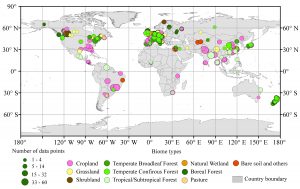
Global pattern and controls of microbial metabolic quotient
A paper was published in the journal Ecological Monographs, the study reports global patterns and controls of microbial metabolic quotient.
The microbial metabolic quotient (MMQ), microbial respiration per unit of biomass, is a fundamental factor controlling heterotrophic respiration, the largest carbon flux in soils. The magnitude and controls of MMQ at regional scale remain uncertain. We compiled a comprehensive data set of MMQ to investigate the global patterns and controls of MMQ in top 30 cm soils. Published MMQ values, generally measured in laboratory microcosms, were adjusted on ambient soil temperature using long-term (30 yr) average site soil temperature and a Q10 = 2. The area-weighted global average of MMQ_Soil is estimated as 1.8 (1.5–2.2) (95% confidence interval) μmol C·h−1·mmol−1 microbial biomass carbon (MBC) with substantial variations across biomes and between cropland and natural ecosystems. Variation was most closely associated with biological factors, followed by edaphic and meteorological parameters. MMQ_Soil was greatest in sandy clay and sandy clay loam and showed a pH maximum of 6.7 ± 0.1 (mean ± se). At large scale, MMQ_Soil varied with latitude and mean annual temperature (MAT), and was negatively correlated with microbial N:P ratio, supporting growth rate theory. These trends led to large differences in MMQ_Soil between natural ecosystems and cropland. When MMQ was adjusted to 11°C (MMQ_Ref), the global MAT in the top 30 cm of soils, the area-weighted global averages of MMQ_Ref was 1.5 (1.3–1.8) μmol C·mmol MBC−1·h−1. The values, trends, and controls of MMQ_Soil add to our understanding of soil microbial influences on soil carbon cycling and could be used to represent microbial activity in global carbon models.
http://onlinelibrary.wiley.com/doi/10.1002/ecm.1258/abstract

